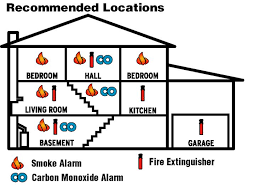
Tips for installing smoke alarms
- Install smoke alarms on every level of your home, including the basement, ensuring that there is an alarm outside every separate sleeping area. New homes are required to have a smoke alarm in every sleeping room and all smoke alarms must be interconnected.
- Hard-wired smoke alarms operate on your household electrical current. They can be interconnected so that every alarm sounds regardless of the fire's location. This is an advantage in early warning because it gives occupants extra time to escape if they are in one part of the home and a fire breaks out in another part. Alarms that are hard-wired should have battery backups in case of a power outage and should be installed by a qualified electrician.
- If you sleep with bedroom doors closed, have a qualified electrician install interconnected smoke alarms in each room so that when one alarm sounds, they all sound.
- If you or someone in your home is deaf or hard of hearing, consider installing an alarm that combines flashing lights, vibration, and/or sound.
- Mount smoke alarms high on walls or ceilings (remember, smoke rises). Ceiling mounted alarms should be installed at least 4 inches away from the nearest wall; wall-mounted alarms should be installed 4 to 12 inches away from the ceiling.
- If you have ceilings that are pitched, install the alarm near the ceiling's highest point.
- Don't install smoke alarms near windows, doors or ducts where drafts might interfere with their operation.
- Never paint smoke alarms. Paint, stickers, or other decorations could keep the alarms from working.
